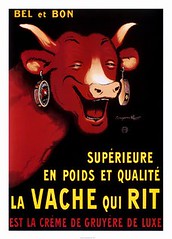Paris, the summer of 1973 - I am a diminutive 6 year old. Dressed like a porcelain doll in my favourite crisp peach cotton dress that falls from the hip into three deep frills scalloped with lace, I feel special.
Across my bodice are intricate embroideries of flowers, birds and butterflies forming exotic, random circular motifs – to wear this dress meant that we must be going somewhere extra nice – for this is an expensive dress. But as fate would have it, my pride would tumble during an altercation with my food. That afternoon I was to walk in the glaring sun feeling humiliated down the Champs Elysées, ashamed of the bright splashes of Bouillabaisse
on my skirt.
My dramatic self-saucing happened whilst lunching in the care of my parents under a portrait of a young HRH Queen Elizabeth II, herself dressed in an extravagant yellow tulle evening gown. It was said that she too had dined on the same classic Mediterranean seafood dish in the very same venue. Even after all these years the flavour of that particular Bouillabaisse lingers in my memory today, redolent with saffron and tomato, rich, warm and fishy - like a stroll on a pier at the height of a summer’s day - and the garlicky stains it left as I missed my mouth and launched it into my lap, leaning up to a too high table.
But in fact, that was actually to be the second humbling moment of the day, in my precocious epicurean upbringing. For that morning I had another more simple, though thoroughly iconic Gallic awakening of the tastebuds, accompanied by yet more childhood embarrassment.
I was standing in a pool of the morning sun streaming through the window of the Pensione dining room. I squinted upwards to look at the lovely Châtelaine, when she produced a small triangular silver parcel from a round cardboard box. Pulling a red tab, she deftly unwrapped it and placed it in my palm, motioning for me to eat it. I looked at the creamy triangular lump on the splayed open foil and gingerly stroked the surface suspiciously. Afraid of offending the kind lady I bit it in half. THOCKKK! The gooey concoction glued itself determinedly to the roof of my mouth and as my little face contorted with discomfort and confusion, Madame doubled up with laughter at the sight of it. This was my first experience of La Vache Qui Rit.
Towards the end of World War 1, Fromageries Bel in Jura, created La Vache Qui Rit as a result of melting down left overs, creating a “fromage fondu”. Bel were at the time a maturation house for cheese and did not produce any cheeses of their own, so unsold stock of Comté, Gruyere and Emmental, were melted down and milk was added. The cheese was cooked which allowed for a long shelf life and packaged.
The recipe was continually revised and was initially sold as a pasteurised product in round metal containers, becoming known as a “Modern Cheese” in that it broke the tradition of provincial cheeses by establishing a national product. It is reputed to be the first cheese to become a registered product (1921). The triangular portions came about in acknowledgement of a rising demand for snack foods. Innovative with marketing, they were one of the first companies to include promotional items such as free children’s trading cards and sponsorship of events such as cycling races.
The now famous laughing cow image, named the “Wachkyrie” was a parody of the cow that appeared on German supply trucks during the war, known as Valkyrie - in reference to the mythical creatures who provided sustenance and care to the Norse Gods in battle. Benjamin Rabier, the celebrated Graphic Designer and Illustrator was commissioned to draw the laughing cow from one of Leon Bel’s own sketches. That design was used until the 1950’s, when it was further simplified to the again slightly modified, graphic image still in use today.
Fromageries Bel exports La Vache Qui Rit to Australia from Slovenia, one of their 14 factories outside of France. The USA has their own factory, which came about when the South Beach Diet rocketed up sales by including the low fat version of LVQR in its list of recommended products. Bel were expecting a mere sales spike, but while the interest in the diet has receded, their market share continues to grow. The brand is also ingrained in the Vietnamese food culture as a consequence of the much-loathed French colonial period.
I didn’t touch LVQR again until I was an adult and it then became one of my pantry staples. Mr Stickyfingers shares my enjoyment, but we have recently moved on, preferring Vache Grosjean - La Vache Sérieuse, which is still made in France. We keep it in the fridge so as to avoid glueing up my chops during gobbling. I’ve found it’s also a wonderful addition to French style Macaroni Cheese, something quite irresistible to children - and adults in need of simple comfort food.

No comments:
Post a Comment